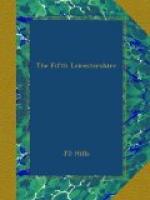The new Divisional Commander, Major General W. Thwaites, R.A., arrived soon afterwards, and soon made himself known to all units, introducing himself with a ceremonial inspection. Ours was at Bailleulmont, where we were billeted for a few days, and on the afternoon of the 13th we formed up 650 strong to receive him. After inspecting each man very carefully, the General addressed the Battalion, calling Col. Jones “Col. Holland,” and us the 5th Leicesters, two mistakes which were never forgotten, though soon forgiven.
He congratulated us on our appearance, and said that he read determination in our faces, promising to know us better by seeing us in the trenches. We then marched past him and went home.
Our first few tours in this new sector might well be described as a nightmare of H squaredO and H squaredS. It rained very hard, and all the trenches at once became full of water—in some places so full that the garrison, as the weather was warm, discarded trousers and walked about with shirts tucked into sandbag bathing drawers. Some of the communication trenches were in a particularly bad condition, and worst of all was the very deep Berlin Trench running alongside the road from Bienvillers to Hannescamps. A sort of “Southend-pier” gridded walk had been built into one side of this about four feet from the floor of the trench, and in some places even this was covered, so that the water in the trench itself was nearly six feet deep. Pumps proved almost useless, and it was obvious that something drastic would have to be done if we were to remain in this part of the world for the winter.
The H squaredS was in cylinders. For some unknown reason the Special Brigade R.E., or “gas merchants” as they were more popularly called, considered the Monchy hollow a particularly suitable place for their poison attacks. The result was that we spent all our rest periods carrying very heavy cylinders into the line or out again, terribly clumsy, awkward and dangerous things to carry, while our trenches, already ruined by the weather, were still further damaged, under-cut and generally turned upside down to make room for these cylinders. Then again, the actual gas projection caused a most appalling amount of trouble. The wind had to be exactly West, for a touch of North or South would carry the poison over our miserable little salient, but at times the wind was due East, and on one occasion it remained obstinately in the wrong quarter for three weeks, while we lived in daily terror of some chance Boche shell hitting one of the cylinders. On several occasions we had to assist with smoke candles and smoke bombs, and this, too, caused us much worry. Perhaps at dusk the wind would be favourable, and orders would arrive that gas would be discharged at 11-34. At 11-34 we, having heard nothing to the contrary, would light our smoke machines, and find no gas turned on. At 12-55 we should get another message by some orderly to say “discharge postponed until 12-55”—then, of course, no time to warn anybody, and no smoke left.




